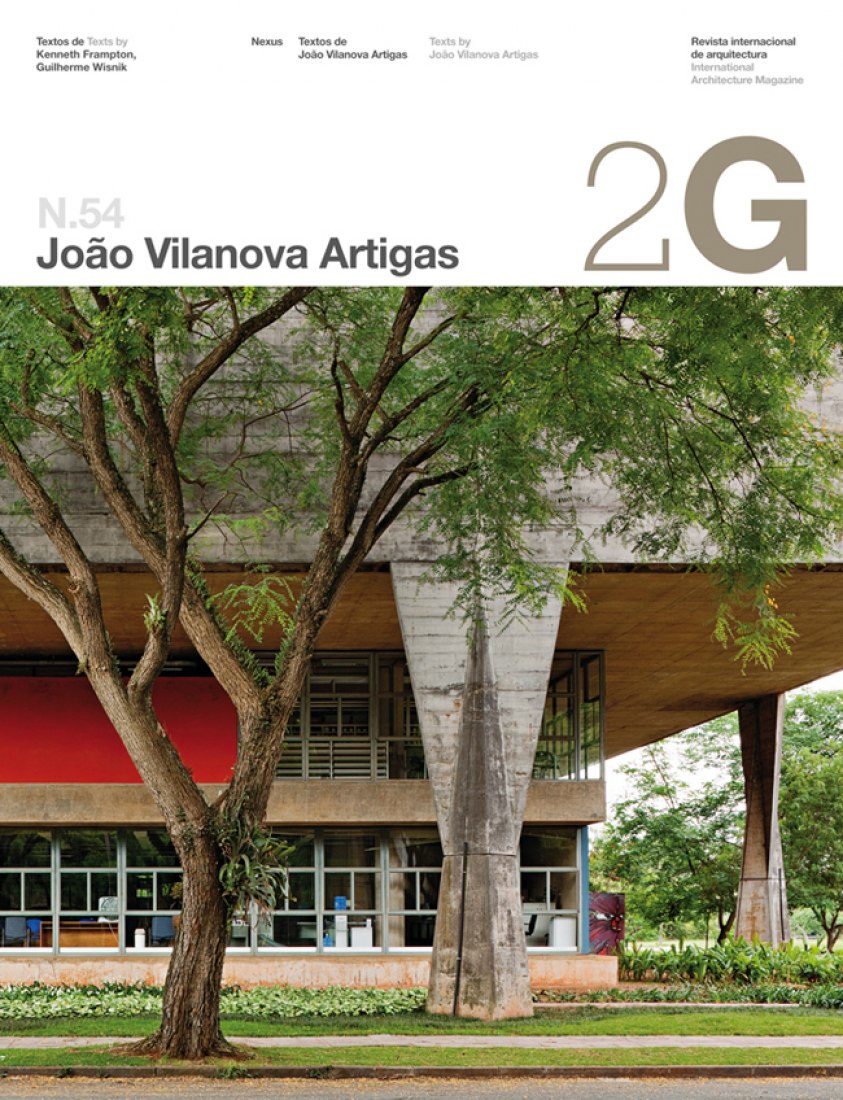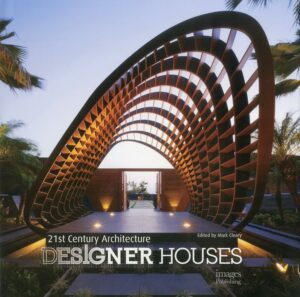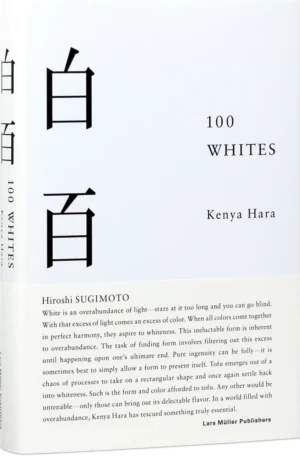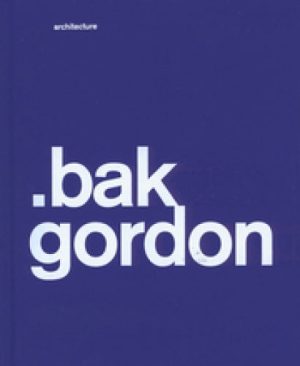a cura di Guilherme Wisnik
João Vilanova Artigas (Curitiba 1915-São Paulo 1985) was a Brazilian architect, a maestro of the so-called ‘São Paulo School’ who at the end of the 1950s adopted reinforced concrete as an expressive constructional language. Basing himself on the technical possibilities of this material, he defined the volumetry of his buildings by means of daring structural concepts using huge spans. His projects and built works convey a wish to be exemplary and to contribute thereby to the country’s technical and social development, an ambition typical of the city of São Paulo: the economic and industrial centre of Brazil, aloof from the hedonistic optimism of Río de Janeiro and its modern architecture, associated with Oscar Niemeyer.
For the first time outside of Brazil, 2G presents the widest selection of the work of this great architect, considered to be the key figure of the architecture created in São Paulo in the 1960s and 70s. An oeuvre defined by the meeting of poetic disquiet and constructional rigour, which has crossed the frontiers of Brazilian architecture in recent years thanks to the international dissemination of the work of Paulo Mendes da Rocha (1928).
João Vilanova Artigas’s work, which spans five decades in all, is prolific and extensive. Unfortunately, much of this work is in a precarious state of preservation today. As a result, the most expressive group of works that are well-or reasonably well-preserved consists of single-family houses and apartment buildings. These we have chosen according to criteria of aesthetic and discursive importance, mainly from the so-called ‘brutalist’ phase, which is without doubt the architect’s most personal and radical. Oustanding among these are the Louveira Building (1946-1949), Vilanova Artigas’s second house (1949), the Baeta House (1956-1957), the Rubens de Mendonça House (1958-1959), the second Taques Bittencourt house (1959), the Ivo Viterito House (1962-1963), the Mendes André House (1966-1967), the Elza Berquó House (1967) and the Martirani House (1969-1974), all in São Paulo.
To this group we have added a few fundamental public buildings, like Guarulhos High School (1960-1962), the CECAP Zezinho Magalhães Prado housing complex (1967-1972), the bus stations in Londrina (1950-1952) and Jaú (1973-1975), and the building for the Faculty of Architecture and Planning of the Universidade de São Paulo (FAU-USP, 1961-1968), his masterpiece. Vilanova Artigas’s political and architectural ideal was to build for the community, hence the fact that it was in the programme of public buildings that his philosophy encountered a more favourable and forceful area of exploration.
In nexus we present two texts written by the architect: ‘Paths of modern architecture’ (1952) and ‘The false crisis’ (1965). A combative Marxist thinker, in these writings Vilanova Artigas addresses two crucial moments in his career.
All the photographs that document the buildings have been specially taken for the magazine by Nelson Kon, various project designs have also been expressly redrawn.
Veste editoriale: Brossura
Formato: 23×30
Pagine: 145
Lingua: E-GB
Anno: 2010
ISBN: 9788425223532
Potrebbero interessarti anche:
Prodotti correlati
-
21st Century Architecture: DESIGNER HOUSES
72,00 € Aggiungi al carrello -
In Offerta
20TH CENTURY EUROPEAN RATIONALISM
110,00 €Il prezzo originale era: 110,00 €.99,00 €Il prezzo attuale è: 99,00 €. Aggiungi al carrello -
100 WHITE
40,00 € Aggiungi al carrello -
In Offerta
(WELL) CONNECTED ARCHITECTURE
48,00 €Il prezzo originale era: 48,00 €.39,00 €Il prezzo attuale è: 39,00 €. Aggiungi al carrello
a cura di Guilherme Wisnik
João Vilanova Artigas (Curitiba 1915-São Paulo 1985) was a Brazilian architect, a maestro of the so-called ‘São Paulo School’ who at the end of the 1950s adopted reinforced concrete as an expressive constructional language. Basing himself on the technical possibilities of this material, he defined the volumetry of his buildings by means of daring structural concepts using huge spans. His projects and built works convey a wish to be exemplary and to contribute thereby to the country’s technical and social development, an ambition typical of the city of São Paulo: the economic and industrial centre of Brazil, aloof from the hedonistic optimism of Río de Janeiro and its modern architecture, associated with Oscar Niemeyer.
For the first time outside of Brazil, 2G presents the widest selection of the work of this great architect, considered to be the key figure of the architecture created in São Paulo in the 1960s and 70s. An oeuvre defined by the meeting of poetic disquiet and constructional rigour, which has crossed the frontiers of Brazilian architecture in recent years thanks to the international dissemination of the work of Paulo Mendes da Rocha (1928).
João Vilanova Artigas’s work, which spans five decades in all, is prolific and extensive. Unfortunately, much of this work is in a precarious state of preservation today. As a result, the most expressive group of works that are well-or reasonably well-preserved consists of single-family houses and apartment buildings. These we have chosen according to criteria of aesthetic and discursive importance, mainly from the so-called ‘brutalist’ phase, which is without doubt the architect’s most personal and radical. Oustanding among these are the Louveira Building (1946-1949), Vilanova Artigas’s second house (1949), the Baeta House (1956-1957), the Rubens de Mendonça House (1958-1959), the second Taques Bittencourt house (1959), the Ivo Viterito House (1962-1963), the Mendes André House (1966-1967), the Elza Berquó House (1967) and the Martirani House (1969-1974), all in São Paulo.
To this group we have added a few fundamental public buildings, like Guarulhos High School (1960-1962), the CECAP Zezinho Magalhães Prado housing complex (1967-1972), the bus stations in Londrina (1950-1952) and Jaú (1973-1975), and the building for the Faculty of Architecture and Planning of the Universidade de São Paulo (FAU-USP, 1961-1968), his masterpiece. Vilanova Artigas’s political and architectural ideal was to build for the community, hence the fact that it was in the programme of public buildings that his philosophy encountered a more favourable and forceful area of exploration.
In nexus we present two texts written by the architect: ‘Paths of modern architecture’ (1952) and ‘The false crisis’ (1965). A combative Marxist thinker, in these writings Vilanova Artigas addresses two crucial moments in his career.
All the photographs that document the buildings have been specially taken for the magazine by Nelson Kon, various project designs have also been expressly redrawn.
Veste editoriale: Brossura
Formato: 23×30
Pagine: 145
Lingua: E-GB
Anno: 2010
ISBN: 9788425223532
Potrebbero interessarti anche:
Prodotti correlati
-
In Offerta
1000 DETTAGLI DI ARREDAMENTO
35,00 €Il prezzo originale era: 35,00 €.30,00 €Il prezzo attuale è: 30,00 €. Aggiungi al carrello -
100 WHITE
40,00 € Aggiungi al carrello -
.BAK GORDON
59,00 € Aggiungi al carrello -
In Offerta
(WELL) CONNECTED ARCHITECTURE
48,00 €Il prezzo originale era: 48,00 €.39,00 €Il prezzo attuale è: 39,00 €. Aggiungi al carrello
FAQ
Leggi le domande frequenti per avere maggiori informazioni sui metodi di pagamento, la spedizione e molto altro
Per acquistare uno o più libri è sufficiente compilare l’apposito modulo al quale si accede dalla scheda di ciascun libro.
Qualora i volumi ordinati non siano tutti immediatamente disponibili, il nostro staff si riserva di contattarti via mail per concordare le modalità di spedizione (A: invio immediato dei volumi presenti a magazzino e successivo invio di quelli mancanti – B. invio unico dopo il ricevimento da parte nostra dei volumi mancanti).
N.B. la fattura deve essere esplicitamente richiesta al momento dell’ordine, comunicando la ragione sociale completa di partita IVA e/o Codice Fiscale e Codice SDI.
Ai sensi dell’Art.5 del relativo Decreto, l’acquirente ha il diritto di recedere dal contratto e restituire i volumi ordinati entro 10 giorni lavorativi, purchè nel medesimo stato in cui li ha ricevuti. Il diritto di recesso dovrà essere esercitato mediante invio di lettera raccomandata A.R. a: LIMOND S.a.s. – via Arnolfo di Cambio 24/A – 37138 Verona (VR) – entro il termine di 10 (dieci) giorni lavorativi dal ricevimento dei volumi.
Tutti i resi dovranno essere autorizzati da Limond S.a.s (tel. +393472455641) con l’assegnazione di un numero di autorizzazione alla resa. Le spese di spedizione saranno interamente a carico del cliente e non si accetteranno pacchi in contrassegno.
Al ricevimento dei volumi, e verificata la loro integrità, Limond S.a.s. provvederà, entro 10 (dieci) giorni, ad accreditare il cliente del valore dei volumi restituiti.
La tempestività nell’evasione dell’ordine è determinata dalla disponibilità della merce ordinata. In caso di immediata disponibilità l’ordine verrà evaso entro 2 giorni lavorativi. Qualora uno o più libri non dovessero essere presenti a magazzino possono essere ordinati su richiesta; il nostro staff informerà il cliente, via mail, circa i tempi necessari per l’evasione dell’ordine.
Pagamento tramite bonifico bancario anticipato alle coordinate comunicate in fase di check-out
I costi di invio (che comprendono imballo e spedizione) per libri e riviste in ITALIA sono i seguenti:
Servizio postale: 3-5 gg (per merce immediatamente disponibile presso il nostro magazzino)
- Spedizioni per acquisti fino a 62,00€: €5,50
- Spedizioni per acquisti fino a 120,00€: €9,50
- Spedizioni per acquisti superiori a 120,00€: Gratuite
Per una quotazione dei costi di invio in EUROPA o per spedizioni internazionali vengono richiesti i seguenti dati:
- Nome/Cognome
- Indirizzo (comprensivo di Codice postale)
- Telefono (meglio se Cellulare)
Alla conferma di accettazione, verranno comunicate coordinate bancarie/account PayPal da utilizzare per il pagamento. Un Una volta ricevuto, verrà evasa la spedizione inoltrando notifica e tracciabiltà.








